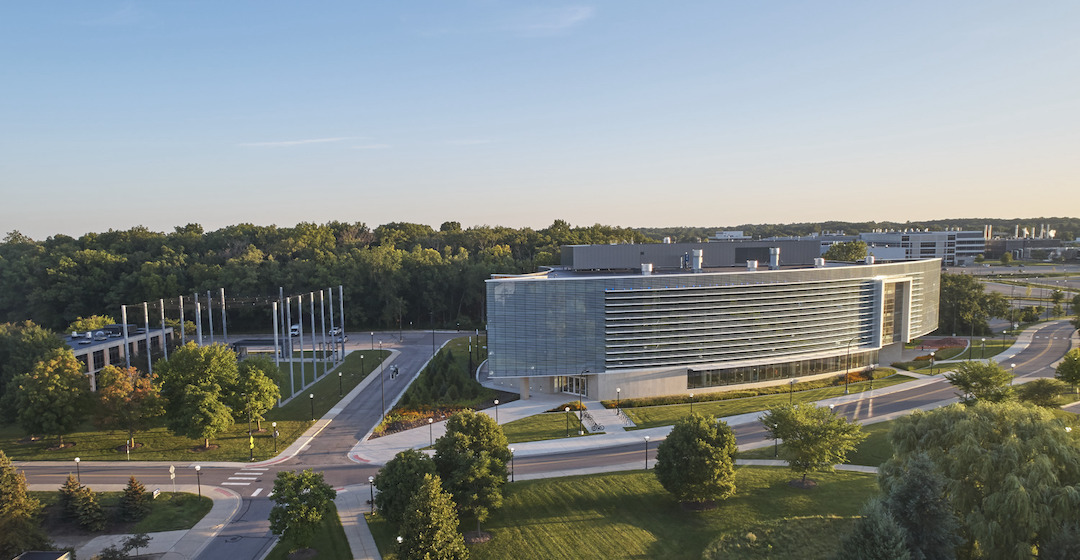The Ford Robotics Building has completed and opened on the University of Michigan (U-M) campus. The $75 million project represents a singular new home for the university’s relationship with Ford and acts as a showcase for robotics research, cross disciplinary collaboration, and innovative industry/education collaboration.
Located on the University of Michigan North Campus, the building anchors the west end of a Michigan Avenue mobility testbed that begins in Detroits Corktown neighborhood and runs through Dearborn to Ann Arbor. The four-story, 134,000-sf project is an interdisciplinary center for mathematics, engineering, and computer programming faculty and researchers. The facility will be home to researchers that were previously spread across 23 separate buildings and is also the first robotics facility to co-locate an industry team (Ford’s mobility research center) with a university’s robotics leadership.
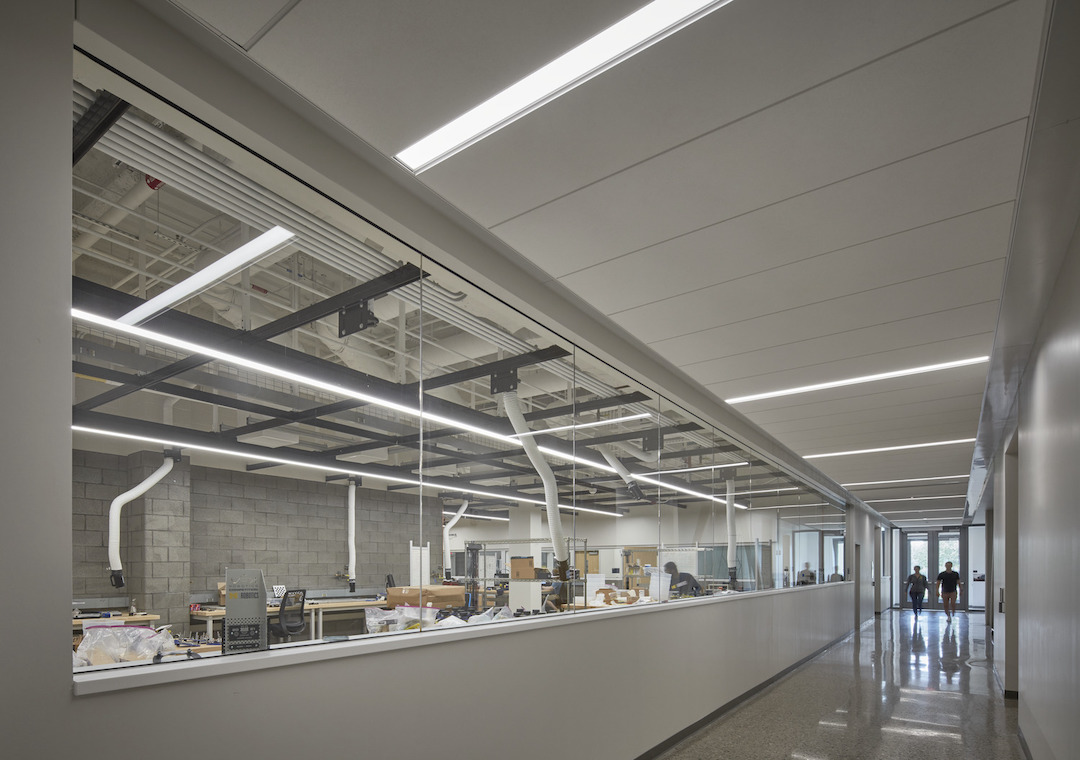
HED, in an effort to reflect a robotics program incorporates both theory and making, designed the building to appear both extroverted and enclosed simultaneously. From the outside, the most striking feature is the glass-clad facade that curves along Hayward Street. Composed of large bands of fritted glass with 30-inch-deep sunshades spaced 42 inches apart, the south-oriented glass wall allows diffused daylight deep into the building interior. The facade also allows visitors to see the activities occurring within.
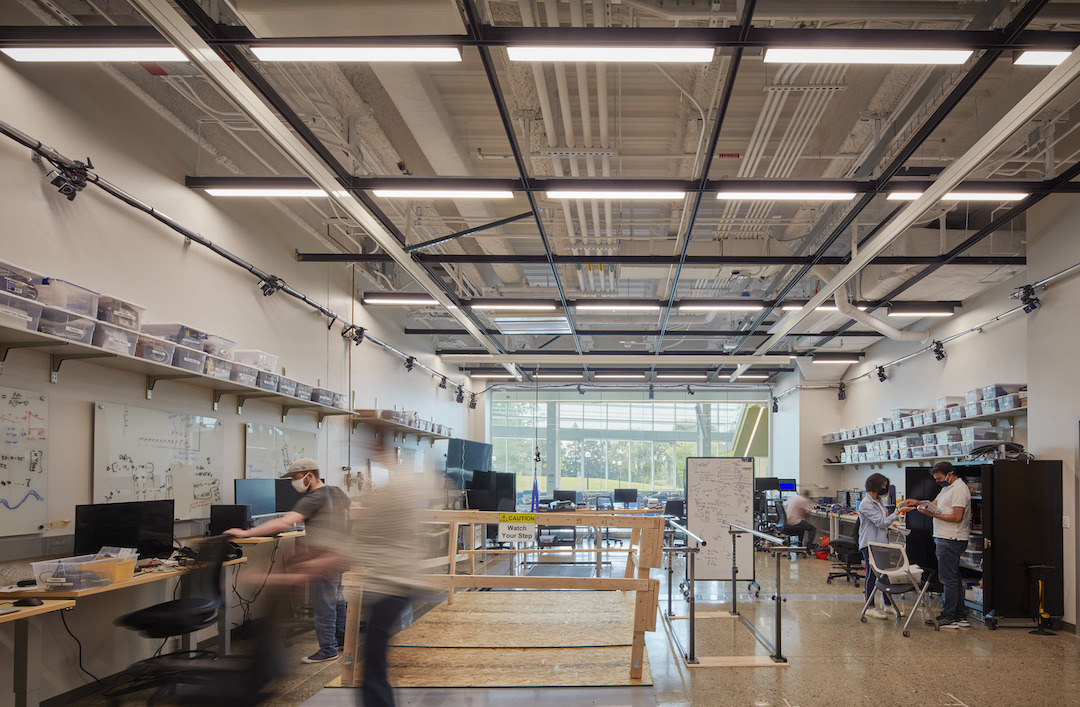
Upon entry, visitors arrive within a four-story atrium defined on one side by the curved smooth-facing glass wall and balconies for the top three floors. The atrium is designed for a wide variety of uses and special events with a cafe, large-scale video screen, and a sophisticated sound system. The atrium is heated through displacement ventilation. Researchers all enter the labs via a shared team collaboration space, ensuring chance encounters, interaction, and collaboration between them.
HED designed the Ford Robotics Building to promote proximity and spontaneous interaction between students, faculty, researchers, and visiting industry professionals. The building includes the new hub of the U-M Robotics Institute on the first three floors and Ford’s robotic and mobility research lab on the fourth floor.
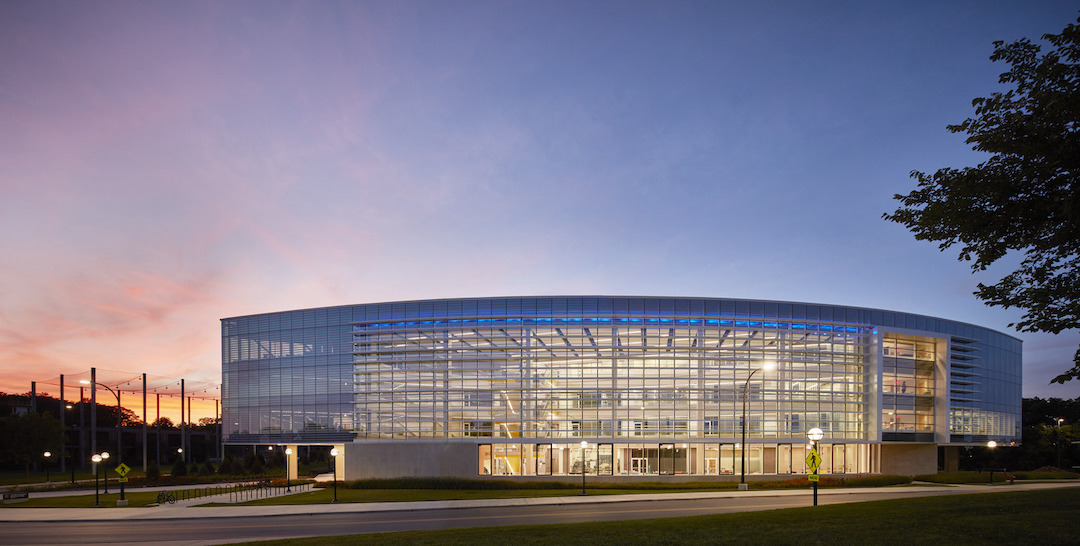
The custom U-M research labs are designed for robots that fly, walk, roll, and augment the human body. Multiple labs are incorporated within the building, including the Ronald D. And Regina C. McNeil Walking Robotics Laboratory for developing and testing legged robots. This specific lab has an in-ground treadmill that can hit 31 mph and a 20% grade, as well as carry obstacles to test walking robots that could aid in disaster relief and lead to better prosthetics and exoskeletons. A rehabilitation lab is designed for advanced prosthetics and robotic controls with a movable “earthquake platform” that can tilt in any direction while force-feedback plates measure ground contact.
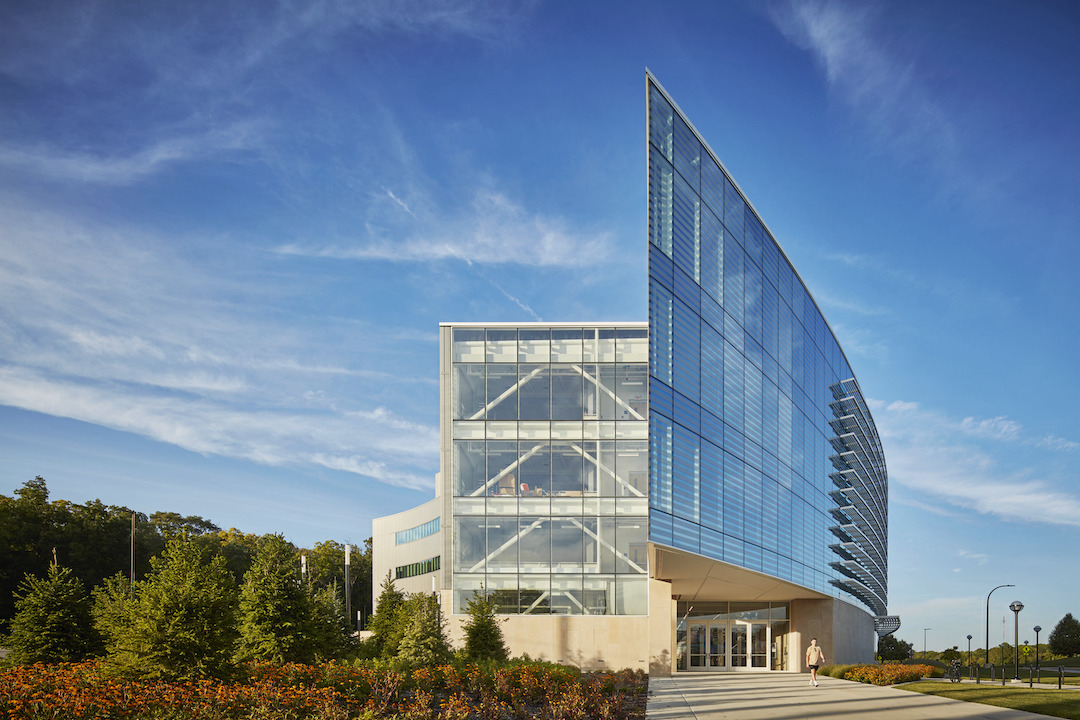
A three-story fly zone allows for the testing of drones and other autonomous aerial vehicles indoors. An outdoor Mars yard was designed with input from planetary scientists at U-M and NASA to enable researchers and student teams to test rover and lander concepts on a landscape that mimics the Martian surface. An AI-designed “robot playground” outdoor obstacle course is designed for testing robots on stairs, rocks, and water surrounded by motion capture cameras. A high-bar garage space for self-driving cars allows for teams to test connected and automated vehicles in urban and suburban environments. Ford roboticists occupy the building’s fourth floor research lab and offices.
The Ford Robotics Building is expected to achieve LEED Gold certification. HED provided architecture, landscape architecture, interior design, and structural, mechanical, and electrical engineering services on the project.
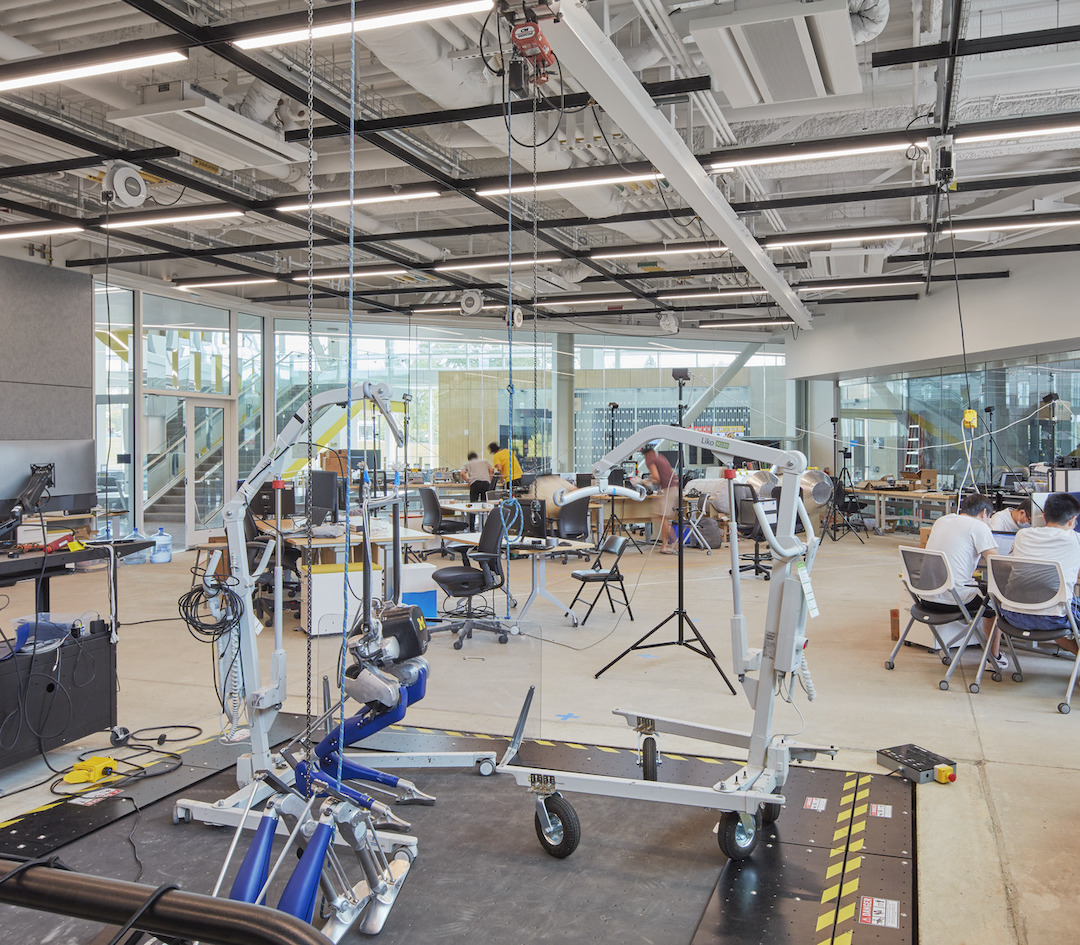
Related Stories
| Aug 11, 2010
Residence hall designed specifically for freshman
Hardin Construction Company's Austin, Texas, office is serving as GC for the $50 million freshman housing complex at the University of Houston. Designed by HADP Architecture, Austin, the seven-story, 300,000-sf facility will be located on the university's central campus and have 1,172 beds, residential advisor offices, a social lounge, a computer lab, multipurpose rooms, a fitness center, and a...
| Aug 11, 2010
University of Florida's traditionally modern graduate building
The University of Florida's Hough Hall Graduate Studies Building was designed by Rowe Architects, Tampa, and Sasaki Associates, Boston, to blend with the school's traditional collegiate gothic architecture outside, but reflect a 21st-century education facility inside. Tallahassee-based Ajax Building Corporation is constructing the $19 million facility, which will have traditional exterior detai...
| Aug 11, 2010
Construction under way on LEED Platinum DOE energy lab
Centennial, Colo.-based Haselden Construction has topped out the $64 million Research Support Facilities, located on the U.S. Department of Energy’s National Renewable Energy Laboratory (NREL) campus in Golden, Colo. Designed by RNL and Stantec to achieve LEED Platinum certification and net zero energy performance, the 218,000-sf facility will feature natural ventilation through operable ...
| Aug 11, 2010
Stimulus funding helps get NOAA project off the ground
The award-winning design for the National Oceanic and Atmospheric Administration’s new Southwest Fisheries Science Center replacement laboratory saw its first sign of movement last month with a groundbreaking ceremony held in La Jolla, Calif. The $102 million project is funded primarily by the American Recovery and Reinvestment Act.
| Aug 11, 2010
New Jersey's high-tech landscaping facility
Designed to enhance the use of science and technology in Bergen County Special Services' landscaping programs, the new single-story facility at the technical school's Paramus campus will have 7,950 sf of classroom space, a 1,000-sf greenhouse (able to replicate different environments, such as rainforest, desert, forest, and tundra), and 5,000 sf of outside landscaping and gardening space.
| Aug 11, 2010
Florida International University's cantilevered design
Suffolk Construction's Miami-Dade business unit is serving as GC for the $14 million School of International and Public Affairs building at the University Park Campus of Florida International University. Designed by Arquitectonica, Miami, the five-story, 58,408-sf building will have a café and three auditoriums on the ground level; the largest auditorium will have a 40-foot cantilever abov...
| Aug 11, 2010
Research Facility Breaks the Mold
In the market for state-of-the-art biomedical research space in Boston's Longwood Medical Area? Good news: there are still two floors available in the Center for Life Science | Boston, a multi-tenant, speculative high-rise research building designed by Tsoi/Kobus & Associates, Boston, and developed by Lyme Properties, Hanover, N.
| Aug 11, 2010
Precast All the Way
For years, precast concrete has been viewed as a mass-produced product with no personality or visual appeal—the vanilla of building materials. Thanks to recent technological innovations in precast molds and thin veneers, however, that image is changing. As precast—concrete building components that are poured and molded offsite—continues to develop a vibrant personality all it...
| Aug 11, 2010
Living and Learning Center, Massachusetts College of Pharmacy & Health Sciences
From its humble beginnings as a tiny pharmaceutical college founded by 14 Boston pharmacists, the Massachusetts College of Pharmacy & Health Sciences has grown to become the largest school of its kind in the U.S. For more than 175 years, MCPHS operated solely in Boston, on a quaint, 2,500-student campus in the heart of the city's famed Longwood Medical and Academic Area.
| Aug 11, 2010
Giants 300 University Report
University construction spending is 13% higher than a year ago—mostly for residence halls and infrastructure on public campuses—and is expected to slip less than 5% over the next two years. However, the value of starts dropped about 10% in recent months and will not return to the 2007–08 peak for about two years.


